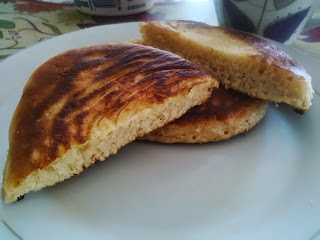My sister wanted a nice breakfast this morning, instead of boring toast. For us that means pancakes! She decided to experiement a little with some sweet potato flour, locally made.
The recipe is a variation on one she took from a Reader's Digest magazine. She swapped out some of the wheat flour for sweet potato flour and we were very impressed with the results. The pancakes were light, fluffy and sweet.
This sweet potato flour is made from locally grown, white sweet potatoes. The flour may be naturally sweet. If you want the pancakes to be less sweet, halve the sugar.
INGREDIENTS
1 cup plain white flour (wheat)
1 cup sweet potato flour
4 tbsp brown sugar
4 tsp baking powder
3/4 tsp salt
2 cups milk
4 tbsp melted butter
2 eggs
1 tsp vanilla extract
1/4 tsp ground cinnamon
METHOD
1. Sift flour twice and combine with other dry ingredients.
2. Beat eggs with vanilla extract until fluffy.
3. Stir together milk, egg and melted butter.
4. Add the liquid mixture to the dry ingredients and mix until just combined. The sweet potato flour seems to be more absorbent compared to regular plain (wheat) flour. Add a bit more milk, if you find the batter is very thick.
5. Heat a non-stick pan to medium heat.
6. Cook pancakes- a quarter cup of batter makes a decent sized pancake. Pour a quarter cup of batter onto the hot pan and cook on one side until bubbles just begin to form on the top. Once bubbles start to form, flip over the pancake and cook the other side. Cook untill golden brown on both sides.
Serve warm with toppings of your choice.
1 cup plain white flour (wheat)
1 cup sweet potato flour
4 tbsp brown sugar
4 tsp baking powder
3/4 tsp salt
2 cups milk
4 tbsp melted butter
2 eggs
1 tsp vanilla extract
1/4 tsp ground cinnamon
METHOD
1. Sift flour twice and combine with other dry ingredients.
2. Beat eggs with vanilla extract until fluffy.
3. Stir together milk, egg and melted butter.
4. Add the liquid mixture to the dry ingredients and mix until just combined. The sweet potato flour seems to be more absorbent compared to regular plain (wheat) flour. Add a bit more milk, if you find the batter is very thick.
5. Heat a non-stick pan to medium heat.
6. Cook pancakes- a quarter cup of batter makes a decent sized pancake. Pour a quarter cup of batter onto the hot pan and cook on one side until bubbles just begin to form on the top. Once bubbles start to form, flip over the pancake and cook the other side. Cook untill golden brown on both sides.
Serve warm with toppings of your choice.










